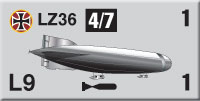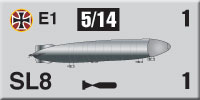| Zeppelins:
German Airships, Part One
By Mike Bennighof, Ph.D.
November 2022
 In a previous installment we looked at some of the pieces from Great War at Sea: Zeppelins, all of the ones that aren’t German. Zeppelins has 88 super-sized airship pieces, and 52 of them are German Navy airships; another five are German Army craft. In a previous installment we looked at some of the pieces from Great War at Sea: Zeppelins, all of the ones that aren’t German. Zeppelins has 88 super-sized airship pieces, and 52 of them are German Navy airships; another five are German Army craft.
That’s only fitting, since Germany led the way in airship development, and the adaptation of them to military purposes. The German Naval Airship Division operated 83 rigid craft during World War One: 71 built by the Zeppelin Works, eight by Schütte-Lanz, three by Parseval and one by Gross-Basenach.
Zeppelin-built ships had two numbers, which writers then and since have used more or less interchangeable. The builder’s number started with LZ and counted all ships built by the first, whether for Army, Navy or civilian use. The Navy numbered theirs in their own sequence, with the letter L. So airship L30, for example, was sometimes known as LZ62 as well. So we put both numbers on the huge playing pieces of Zeppelins.
Let’s have a look at the German airships of Zeppelins.
The First Class

Between October 1913, when the new zeppelin L2 exploded during a trial flight, and late May 1914, when it accepted the new ship L3, the Naval Airship Division had three untrained crews but no airships. Division commander Peter Strasser hired the civilian airship Sachsen for training, but that couldn’t make up for dedicated flights in a naval airship. Strasser and his men spent the summer of 1914 familiarizing themselves with the new ship.
L3 was a copy of the original naval airship, L1, which had been lost in an accident off Helgoland. She became the lead ship of the M class, which eventually totaled a dozen ships – six of them served the Navy, and six went to the Army. They had a volume of 794,500 cubic feet and were just under 160 meters long.
The ships were fitted to carry 28 fifty-kilogram (110-pound) bombs, but when the first airships were delivered to the Navy they had no suitable bombs to drop. The Admiralstab suggested dropping 210mm high-explosive shells, which weighed in at 108 kilos. Strasser concluded that that would be a very bad idea, and the naval airships had to wait until October for actual bombs.
These would be the ships that first performed useful scouting missions over the North Sea, and that carried out the first bombing raids over England. The Army’s ships also bombed Paris and Warsaw among other targets. None of them survived the war; the Navy’s last ship of the class was destroyed in a hangar accident in September 1916.
The New Model

A much-improved airship, numbered LZ26, had been under construction for the DELAG airline at the outbreak of war. She had a frame made of duralumin, an alloy of aluminum with a little copper added, that proved both light-weight and strong and would be used in all subsequent Zeppelin-built craft. The gangway was moved inside the body, helping to streamline the hull, control surfaces were improved and perhaps most importantly the gondolas – the structures dangling below the hull and housing the control room and other facilities – were now fully enclosed.
Though only slightly larger than L3, the new ship was much more effective. Following strict German bureaucratic practice, the first ship went to the Army and a second copy was built for the Navy, even though the Zeppelin Works had already designed a larger, even more improved version. The two services had to receive the exact same airship in the exact same quantities, even if a better design was available.
L9, as the Navy numbered its ship, indeed performed very well, undertaking 74 reconnaissance flights and three bombing raids on England before she burned in the same September 1916 hangar fire that claimed L6.
Johann Schütte’s Wooden Airship

In 1909, Professor Johann Schütte and wood-products manufacturer and engineer Karl Lanz joined forces to create the Schütte-Lanz Airship Company. Schütte designed airships with a wooden frame rather than the aluminum used by Ferdinand Graf Zeppelin, making for a less expensive ship. Schütte-Lanz had sold an airship to the Army, but its bid to sell a ship to the Navy failed, apparently due to Schütte’s deeply unpleasant personality. The company was floundering when war gave it new life.
The Navy wanted a much larger airship, and Schütte-Lanz had a design for one ready where the Zeppelin Works did not. The Navy ordered three of the big new design, one of which was diverted to the Army). The Type C introduced a number of innovative features and, at least on paper, was larger with much better performance than the most recent Zeppelin-made ships. But it had a wooden frame, and when SL 3 was delivered to the Naval Airship Division in February 1915, Strasser raged against it.
“Experience has thoroughly demonstrated that wood is an unsuitable material for airship construction,” he wrote, “because it weakens and breaks with even a moderate degree of humidity. Building more wooden ships would only increase the number of ships useless for combat.”
Despite Strasser’s hatred, the Navy continued to order airships from Schütte-Lanz. One larger Type D entered service in late 1915, and four still-larger Type E airships in 1916 (as with the Zeppelin airships, each ship delivered to the Navy by Schütte-Lanz was matched by one delivered to the Army). Some of the Schütte-Lanz ships participated in the larger raids on England and a few reconnaissance flights over the North Sea, but for the most part Strasser exiled them to the Baltic theater.
The Schütte-Lanz ships were big, with a capacity of 1.1 million cubic feet and a length of 153 meters. The last class flown, the Type E, went to 1.3 million cubic feet and 174 meters. They certainly looked impressive, but did not perform nearly as well as the duralumin-framed ships. By the end of the war Schütte-Lanz had begun work on a duralumin-framed ship, but she had not been completed when the war ended. Schütte-Lanz attempted to continue after the war as an airship design firm with little success, but Karl Lanz did sketch a flying aircraft carrier that greatly influenced the American Akron and Macon.
You can order Zeppelins right here.
Sign up for our newsletter right here. Your info will never be sold or transferred; we'll just use it to update you on new games and new offers.
Mike Bennighof is president of Avalanche Press and holds a doctorate in history from Emory University. A Fulbright Scholar and NASA Journalist in Space finalist, he has published a great many books, games and articles on historical subjects; people are saying that some of them are actually good.
He lives in Birmingham, Alabama with his wife and three children.
Want to keep Daily Content free of third-party ads? You can send us some love (and cash) through this link right here.
|
